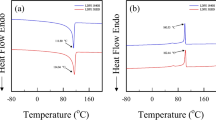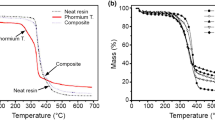Abstract
Polyethylene terephthalate microfibril-reinforced composites with linear low-density polyethylene (LLDPE) matrix were manufactured by four industrial processing methods: compression moulding, slit-die extrusion with calendering, extrusion blow moulding and injection moulding. The microfibrils were generated in situ by blending the two polymers together and thermomechanically processing the blend. Thin sheets were manufactured in all the processes, except injection moulding, which was employed for making containers. The oxygen permeability of the films was determined using a commercial machine. The greatest improvement in oxygen barrier property (compared to neat LLDPE films), was found in the compression-moulded microfibrillar composite (MFC) films. Two existing theoretical models were modified to reasonably forecast the oxygen permeability of compression-moulded MFC films. The parallel filler model provides a very good fit to the experimental data for the full mass ratio range. The Lewis and Nielsen model was also trialled for various polymer combinations, producing reasonable results with minor modifications.











Similar content being viewed by others
References
Evstatiev M, Fakirov S (1992) Microfibrillar reinforcement of polymer blends. Polymer 33(4):877–880
Evstatiev M, Fakirov S, Krasteva B, Friedrich K, Covas JA, Cunha AM (2002) Recycling of poly(ethylene terephthalate) as polymer–polymer composites. Polym Eng Sci 42(4):826–835
Lin XD, Jia D, Leung FKP, Cheung WL (2004) Study on poly(ethylene terephthalate)/polypropylene microfibrillar composites. II. Solid-state drawing behavior. J Appl Polym Sci 93(4):1989–2000
Fakirov S, Shields RJ, Fuchs C, Friedrich K, Bhattacharyya D (2008) Polyolefin/PET microplates–reinforced composites with improved barrier properties. Int J Polym Mater 57(1):33–53
Bhattacharyya D, Shields RJ (2010) Modeling of fibre formation and oxygen permeability in micro-fibrillar polymer–polymer composites. In: Dattaguru B, Gopalakrishnan S, Aatre VK (eds) IUTAM symposium on multi-functional material structures and systems, IUTAM Book Series, vol 19. Springer, Berlin, pp 111–119
Shields RJ, Bhattacharyya D, Fakirov S (2008) Oxygen permeability analysis of microfibril reinforced composites from PE/PET blends. Composite A 39(6):940–949
Shields RJ (2008) Characterisation of the mechanical and oxygen barrier properties of microfibril reinforced composites. PhD Thesis, The University of Auckland
Tan S, Somashekar AA, Bhattacharyya D (2012) Influence of processing conditions on the permeability of microfibril-reinforced composites. In: Kelly PA, Bickerton S (eds) Flow processes in composite materials FPCM-11 proceedings. Auckland, pp 378–385
Jayanarayanan K, Thomas S, Joseph K (2012) Effect of blend ratio on the mechanical and sorption behaviour of polymer–polymer microfibrillar composites from low-density polyethylene and polyethylene terephthalate. J Reinforced Plast Compos 31(8):549–562
Massey LK (2003) Permeability properties of plastics and elastomers—a guide to packaging and barrier materials. Plastics design library, 2nd edn. William Andrew Publishing, Norwich
Moyssiadi T, Badeka A, Kondyli E, Vakirtzi T, Savvaidis I, Kontominas MG (2004) Effect of light transmittance and oxygen permeability of various packaging materials on keeping quality of low fat pasteurized milk: chemical and sensorial aspects. Int Dairy J 14(5):429–436
Casalis J, van de Putte J (1962) The packaging of fluid milk. In: Milk hygiene: hygiene in milk production, processing and distribution, world health organization monograph series No. 48. Food and Agriculture Organization of the United Nations and the World Health Organization, Geneva, pp 569–593, http://whqlibdoc.who.int/monograph/WHO_MONO_48_%28p569%29.pdf. Accessed 29 April 2012
Simon GP (2003) Polymer characterization techniques and their application to blends. Oxford University Press, New York
Nielsen LE (1974) The thermal and electrical conductivity of two-phase systems. Ind Eng Chem Fundam 13(1):17–20
Ordóñez-Miranda J, Alvarado-Gil J, Medina-Ezquivel R (2010) Generalized Bruggeman formula for the effective thermal conductivity of particulate composites with an interface layer. Int J Thermophys 31(4):975–986
Sokol R, Nedbal J, Fähnrich J, Ilavský M, Kolařík J (2000) Effect of interphase interactions on the dielectric behaviour of polycarbonate/poly(styrene-co-acrylonitrile) blends. Poly Bull 44(5):555–562
Gonzo EE, Parentis ML, Gottifredi JC (2006) Estimating models for predicting effective permeability of mixed matrix membranes. J Membr Sci 277(1–2):46–54
Chiew YC, Glandt ED (1983) The effect of structure on the conductivity of a dispersion. J Colloid Interface Sci 94(1):90–104
Okamoto S, Ishida H (1999) A new theoretical equation for thermal conductivity of two-phase systems. J Appl Polym Sci 72(13):1689–1697
Giles HF Jr, Wagner JR Jr, Mount EM III (2005) Extrusion: the definitive processing guide and handbook. William Andrew Publishing, Norwich
Mocon (2006) OX-TRAN Model 2/10 Modular System Operator’s Manual. Mocon, Minneapolis
Bhattacharyya D, Shields RJ, Fakirov S (2008) Characterisation and novel applications of fibrillar polymer composites. Adv Mater Res (Durnten-Zurich, Switz.) 47:1278–1281
Utracki LA (2003) Polymer blends handbook, vol 1–2. Springer, Berlin
Friedrich K, Evstatiev M, Fakirov S, Evstatiev O, Ishii M, Harrass M (2005) Microfibrillar reinforced composites from PET/PP blends: processing, morphology and mechanical properties. Compos Sci Technol 65(1):107–116
Fakirov S (2006) Modified Soxhlet apparatus for high-temperature extraction. J Appl Polym Sci 102(2):2013–2014
Li Z-M, Yang M-B, Xie B-H, Feng J-M, Huang R (2003) In-situ microfiber reinforced composite based on PET and PE via slit die extrusion and hot stretching: influences of hot stretching ratio on morphology and tensile properties at a fixed composition. Polym Eng Sci 43(3):615–628
Mai Y-W, Wong JSS, Li RKY, Lu C (2004) On the tearing toughness and permeability modelling of polymer nanocomposites. In: Conference proceedings: ANTEC 2004, Vol 2, Chicago, pp 1785–1789
Tan S (2012) Oxygen permeability in micro-fibrillar polymer–polymer composites. ME Thesis, The University of Auckland
Acknowledgements
The authors would like to thank the Ministry of Business, Innovation and Employment, New Zealand Government, for funding this research. They would also like to acknowledge the support of Convex Plastics, Hamilton, New Zealand. Ms Ulrike Kettenberger, Visiting Engineer, and Mr Jimmy Thomas, Technician, contributed to this project.
Author information
Authors and Affiliations
Corresponding author
Rights and permissions
About this article
Cite this article
Tan, S.N.S., Somashekar, A.A. & Bhattacharyya, D. Development and analysis of gas barrier properties of microfibrillar polymer–polymer composites. J Mater Sci 50, 7384–7397 (2015). https://doi.org/10.1007/s10853-015-9296-2
Received:
Accepted:
Published:
Issue Date:
DOI: https://doi.org/10.1007/s10853-015-9296-2




